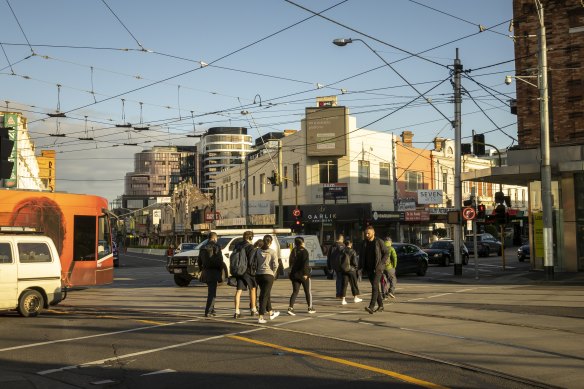- Exclusive
- Politics
- Victoria
- Housing crisis
This was published 1 year ago
Is your suburb going higher? The 10 areas earmarked as hotspots for increasing housing density
By Josh Gordon and Adam Carey
A plan to fit tens of thousands of extra people into 10 “activity centres” dotted across Melbourne is ramping up, with local communities facing a proliferation of multi-storey buildings.
The Department of Transport and Planning has released a fine-grained, street-by-street analysis revealing where future development across Melbourne is most likely to occur in 10 suburban centres targeted for housing growth: Broadmeadows, Camberwell Junction, Chadstone, Epping, Frankston, Moorabbin, Niddrie-Keilor Road, North Essendon, Preston-High Street and Ringwood.

Percy Treyvaud Memorial Park in Chadstone, one of 10 Melbourne suburbs targeted for housing growth.Credit: Paul Jeffers
The government is reviewing height limits and housing design rules in these 10 precincts, and the analysis marks the beginning of what could be a tricky consultation process with local communities worried about the impact the density push might have on urban amenity.
Already, two councils in Melbourne’s leafy east have expressed disquiet about government plans to seize planning powers and densify their local streets.
The government last year announced an overarching ambition to deliver an annual average of 80,000 new homes a year, or 800,000 over a decade.
As a first step, it is promising to build 60,000 new homes in 10 established suburban centres, with a view to eventually expanding its urban consolidation ambitions to 120 locations across greater Melbourne.
Planning Minister Sonya Kilkenny said the government was keen to get feedback from local communities on how to add more housing while also ensuring their suburbs maintain their liveability.
“As part of our landmark Housing Statement we’re enabling 60,000 more homes to be built across established suburbs, ensuring more Victorians have access to affordable housing close to services, jobs and transport,” Kilkenny said.
The government says the 10 suburban centres have been chosen for their potential to accommodate more homes, while ensuring access to train stations, tram services, town centres, job opportunities, and public services.
Planning Institute of Australia Victorian president Patrick Fensham warned the government not to focus so strongly on meeting its housing target that it loses sight of future liveability in the 10 activity centres.
“The ambition for the activity centre planning is 60,000 additional dwellings, or 6000 on average,” Fensham said.
“For some centres, this will represent a step change in density and intensity. A sole focus on the number of dwellings – ‘hitting a dwelling KPI’ – runs the risk of poor development outcomes, pressure on infrastructure, and incomplete future communities, while possibly alienating the people already living in these centres.”
The maps indicate which streets will fall under the control of the state under planning amendments made last year to speed up approvals for projects with construction costs of at least $50 million in Melbourne or $15 million in the regions, provided they include at least 10 per cent affordable housing.
Fensham said there were places on the fringe of the 10 activity centres, such as railway stations, that are good candidates for significantly increased density.

Camberwell Junction is one of 10 places the state government is targeting for increased housing density.Credit: Wayne Taylor
A simple tapering of density away from the heart of each activity centre may not always be appropriate, he said.
Figures released this week by the Bureau of Statistics show Melbourne’s population surged by a record 166,000 in 2022-23, equivalent to 3185 extra people a week. The previous one-year record increase in population was in 2016, when it added 126,000 residents.
Victoria has not been building anywhere enough houses to meet the demands of population growth, nor has the state ever managed to build 80,000 homes in a single year.
The latest figures, for example, show Victorian councils granted approvals to build a total 51,068 houses, flats and townhouses over the year to January – down 17.6 per cent on the same 12-month period a year earlier.
The government’s own estimates suggest the state will need to build at least 57,000 dwellings a year to keep up with population growth, with the number of Victorians expected to swell by about half to 10.3 million by 2051, up from about 6.8 million currently.
The government says it is planning to work closely with local communities and councils to review design requirements and building heights, stressing there will be no single approach, with its consultation process expected to consider a range of factors, including the amount of public open space and community facilities available.
It says the extra population in particular areas could be accommodated in a range of ways, for example, through more social housing, changing height limits or building more apartments and townhouses.
The Morning Edition newsletter is our guide to the day’s most important and interesting stories, analysis and insights. Sign up here.